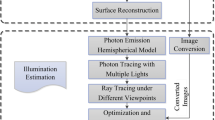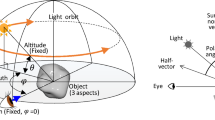Abstract
The traditional multi-viewpoint rendering method for indoor scenes has poor lighting and shadow effects, resulting in too dark or bright indoor scene multi-viewpoint rendering. Therefore, an optimization method for indoor scene multi-viewpoint rendering based on binocular vision is proposed. This research plans light and shadow effects based on the visual relationship between point light sources and indoor scenes; sets rendering points based on binocular vision; and renders indoor scenes with multiple viewpoint angles. The simulation experiment results show that compared with the traditional rendering method, the light and shadow effect of the studied method is excellent, and the rendered indoor scene is suitable for light and dark.
Access this chapter
Tax calculation will be finalised at checkout
Purchases are for personal use only
Similar content being viewed by others
References
Mengyu, J., Ligang, L.: Multi view rendering optimization of indoor scene based on perception. J Univ. Sci. Technol. China 48(2), 140–147 (2018)
Ziyu, W., Yingmin, Z., Yongbin, C., et al.: Optimization of indoor scene semantic segmentation network based on rgb-d image. Automation Information Eng 2, 27–32 (2020)
An, Z., Li, F., Wan, G., et al.: Construction method of indoor and outdoor scene based on BIM and GIS. Digital design 1, 2020, 009 (001):151–153.
Chen, X., Li, P.: Analysis of the light and shadow in the modern architecture’s expression. China Illuminating Eng. J 29(01), 82–86 (2018)
Fu, P., Chen, X., Wu, L.: Research on absolute positioning of binocular vision based on corner. J. Electr. Measur. Instrument 32(03), 1–8 (2018)
Liu, Y., Wang, Z., Liu, Y., et al.: Reversing obstacle detection based on binocular vision image. J. Chongqing Jiaotong Univ. 37(3), 92–98 (2018)
Sun, S., Sun, S.: Precision matching simulation of binocular stereo vision target. Comput. Simul. 35(11), 413–416 (2018)
Liu, S., Liu, D., Srivastava, G., Połap, D., Woźniak, M.: Overview and methods of correlation filter algorithms in object tracking. Complex Intelligent Syst (2020). https://doi.org/10.1007/s40747-020-00161-4
Fu, W., Liu, S., Srivastava, G.: Optimization of big data scheduling in social networks[J]. Entropy 21(9), 902 (2019)
Liu, S., Bai, W., Zeng, N., et al.: A fast fractal based compression for MRI images[J]. IEEE Access 7, 62412–62420 (2019)
Author information
Authors and Affiliations
Editor information
Editors and Affiliations
Rights and permissions
Copyright information
© 2021 ICST Institute for Computer Sciences, Social Informatics and Telecommunications Engineering
About this paper
Cite this paper
Jing, H. (2021). Multi-viewpoint Rendering Optimization of Indoor Scene Based on Binocular Vision. In: Fu, W., Xu, Y., Wang, SH., Zhang, Y. (eds) Multimedia Technology and Enhanced Learning. ICMTEL 2021. Lecture Notes of the Institute for Computer Sciences, Social Informatics and Telecommunications Engineering, vol 388. Springer, Cham. https://doi.org/10.1007/978-3-030-82565-2_36
Download citation
DOI: https://doi.org/10.1007/978-3-030-82565-2_36
Published:
Publisher Name: Springer, Cham
Print ISBN: 978-3-030-82564-5
Online ISBN: 978-3-030-82565-2
eBook Packages: Computer ScienceComputer Science (R0)




